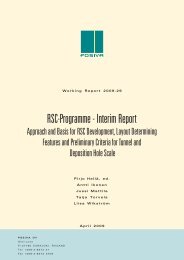A review of porosity and Diffusion in Bentonite (pdf) (2.4 MB) - Posiva
A review of porosity and Diffusion in Bentonite (pdf) (2.4 MB) - Posiva
A review of porosity and Diffusion in Bentonite (pdf) (2.4 MB) - Posiva
You also want an ePaper? Increase the reach of your titles
YUMPU automatically turns print PDFs into web optimized ePapers that Google loves.
275 CONCLUSIONS<strong>Diffusion</strong> <strong>of</strong> various tracers <strong>in</strong> bentonite has been measured <strong>of</strong>ten, but models that canexpla<strong>in</strong> the results are few, <strong>and</strong> unfortunately, <strong>in</strong>complete or afflicted by <strong>in</strong>correct assumptions.The behavior <strong>of</strong> montmorillonite, the m<strong>in</strong>eral that provides bentonite with itsseal<strong>in</strong>g properties, lies at the heart <strong>of</strong> the problem. From the dry state <strong>in</strong> a bentonite pellet,montmorillonite swells up <strong>in</strong> water. Concomitantly, the hydraulic conductivity isreduced to very low values, <strong>and</strong> diffusion becomes the ma<strong>in</strong>, if not the only transportmechanism. <strong>Diffusion</strong> can occur through free porewater, an electrically balanced solution,through diffuse double layer water that is present at the <strong>in</strong>terface with the m<strong>in</strong>eralsurface <strong>and</strong> has a surplus <strong>of</strong> cations, <strong>and</strong> through <strong>in</strong>terlayer water that forms part <strong>of</strong> them<strong>in</strong>eral structure. These three water types have very different diffusional properties, <strong>and</strong>the proportions they take <strong>of</strong> the total <strong>porosity</strong> vary with pack<strong>in</strong>g density <strong>and</strong> solutionchemistry. A structural model was derived that can calculate the proportions. Parameterswere derived from two experiments <strong>and</strong> satisfactory numbers were obta<strong>in</strong>ed forone, but not for the other. The different results may be due to a different orig<strong>in</strong> <strong>of</strong> thebentonites, <strong>and</strong> perhaps, to different preparation <strong>in</strong> the experiment.For assess<strong>in</strong>g the behavior <strong>of</strong> bentonite as a conf<strong>in</strong><strong>in</strong>g material for radioactive waste, amodel is needed that can calculate the diffusion <strong>of</strong> the radioactive elements <strong>in</strong> conjunctionwith environmental <strong>in</strong>teractions that change the properties <strong>of</strong> the bentonite. <strong>Diffusion</strong>through free porewater <strong>and</strong> DDL water can be calculated already with PHREEQC(Appelo <strong>and</strong> Wers<strong>in</strong>, 2007). Interlayer water is a significant part <strong>of</strong> total water <strong>in</strong>bentonite, <strong>and</strong> a module for calculat<strong>in</strong>g diffusion through <strong>in</strong>terlayer water can enhancePHREEQC’s applicability for bentonite. In PHREEQC (like <strong>in</strong> other models), thest<strong>and</strong>ard states (activity scales) are different for the (exchangeable) cations <strong>in</strong> <strong>in</strong>terlayerwater <strong>and</strong> the species <strong>in</strong> free water. Retardation by ion exchange is a crucial part <strong>of</strong> thebarrier properties <strong>of</strong> bentonite. It can be modeled easily if the concentrations <strong>of</strong> the majorions are known. Unfortunately, these have been rarely analyzed <strong>in</strong> diffusion experiments,a situation that needs to be improved to enhance confidence <strong>in</strong> the model<strong>in</strong>g.An experiment is proposed <strong>in</strong> which diffusion <strong>of</strong> tracers (HDO, I - , Cs + , Sr 2+ ) is measured<strong>and</strong> used for model verification <strong>and</strong> for determ<strong>in</strong><strong>in</strong>g model parameters. A bentoniteis to be cleaned from reactive accessory m<strong>in</strong>erals <strong>and</strong> washed. Next, 2 samples are preparedwith 2 different concentrations <strong>of</strong> background-NaCl <strong>and</strong> tracers. Sets <strong>of</strong> the 2samples are clamped together, sliced after given times, <strong>and</strong> analyzed. The experimentwill allow to assess parameters for <strong>in</strong>terlayer diffusion (for Sr 2+ predicted to be counterto the concentration gradient <strong>in</strong> free porewater), <strong>and</strong> the parameters for DDL water(fraction <strong>of</strong> free porewater, potential for calculat<strong>in</strong>g depletion <strong>and</strong> enrichment).
















